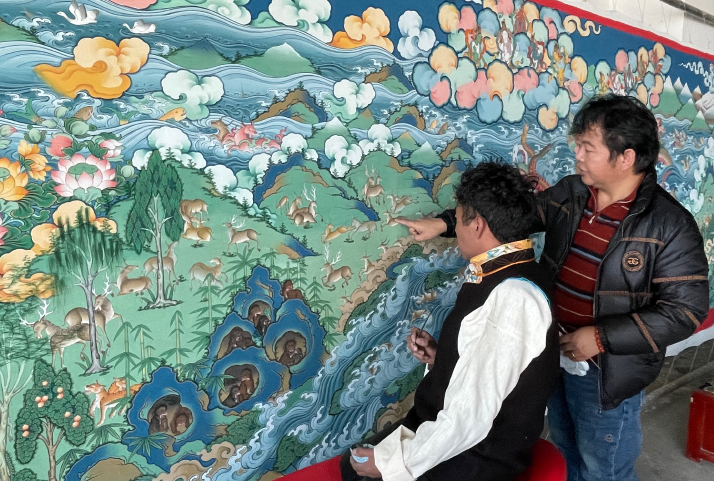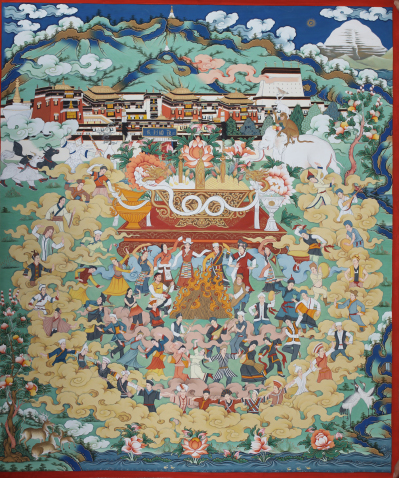| Lifestyle |
| A stroke of cultural genius | |
|
|
 Mansar School Thangka artists create a work in Lhasa, Xizang Autonomous Region, on December 22, 2022 (XINHUA)
The 1,300-year-old Thangka art, a religious painting meticulously crafted on woven material, is often described as an illustrated encyclopedia of Tibetan culture. Celebrated for its artistic and cultural importance, Thangka was officially recognized as part of China's intangible cultural heritage in 2006. One of the key institutions dedicated to the preservation and development of this ancient art form is the Tibet Academy of Thangka (TAT), located in Lhasa, capital of Xizang Autonomous Region. The academy specializes in the Mansar School of Thangka painting, known for its intricate designs and effervescent color palettes. Visitors to the TAT have the rare opportunity to witness the entire creative process of a Mansar School Thangka piece, from initial sketch to final brushstroke. Vitality from creativity "Traditionally, the subject matters expressed in Thangka masterpieces include religion, history and Tibetan medicine. This rich diversity reflects the depth of Tibetan culture," Goinqogyai, Vice President of the TAT, said. The 37-year-old is a fifth-generation Thangka artist in Lhaze County, Xigaze City, about 300 km from Lhasa. He began to learn the art from his uncle at the age of 7 and is now a certified master of the Mansar School Thangka art. Over his three decades practicing the art, Goinqogyai has discovered intricate connections between different forms of art and come to the understanding that he can find inspiration in all art forms for creating Thangka works. In 2016, the TAT dispatched him to study traditional Chinese painting at the Academy of Arts and Designs at Tsinghua University in Beijing. Soon after Goinqogyai attempted to apply the realistic techniques of traditional landscape and bird paintings to Thangka art, he was thrilled by an effect he had never seen before. "It is fabulous to present snow-covered mountains, lakes and forests in a much different way," he recalled. After his experience in Beijing, Goinqogyai began to establish an art style of his own, which integrates elements of traditional Chinese painting with techniques of the Mansar School from the 17th and 18th centuries. To observe nature up close, he often takes trips into the wild to photograph mountains, rivers and lakes, and then later reproduces them with ink and brush. Goinqogyai said he is not the first Thangka artist to conduct such experiments. Manla Dondrub, a Thangka master from the 15th century, borrowed ideas from Chinese landscape painting for his creations. This testifies to the long communication between, and integration of, the many sub-cultures in China and the sense of community among all 56 of the country's ethnic groups. However, Goinqogyai emphasized the importance of not losing Thangka's traditional features during such exchanges. Instead, different art forms should be improved during the discourse, he said.  A Mansar School Thangka piece (XINHUA)
Continuity and change In a studio on the second floor of the TAT, a group of students sits cross-legged on the floor, deeply engrossed in creating their own Thangka art pieces. The only sound breaking the silence is the soft scratching of pens against paper. Crafting a Thangka is a long and intricate process that typically takes six to seven years to master. "Sketching is one of the fundamental skills in Thangka painting," explained Goinqogyai. "The key to success is maintaining a steady hand. It may sound simple, but I spent four years honing that skill." Among the students is Zhaxi Dongzhu, a sixth-year scholar from Gannan, a Tibetan autonomous prefecture in Gansu Province. He is currently focused on perfecting his line drawing, determined to build a solid foundation for his artistic journey. "The academy doesn't charge tuition and provides free lunch every day," he said. "This support is invaluable for students like me who come from modest backgrounds." After graduation, Zhaxi Dongzhu plans to return to his hometown to share the knowledge and skills he has acquired, hoping to inspire a new generation of artists in his community. At the TAT, the dedication to preserving this ancient art form is mirrored in the passion and ambitions of its students. In ancient times, Thangka art was passed down from father to son or from master to apprentice, but exclusive to men only. Women had few rights and opportunities in those days and ordinary people had no access to education. All this changed after Xizang underwent a democratic reform in the 1950s. Today, there are many schools in the region that teach the art, and the percentage of female students is increasing. After cutting short her college education due to health issues, Degyi decided to reignite her passion for painting and was accepted into the program at the TAT. Her ambition is to become an art teacher upon graduation, sharing her love for Thangka with others. The training of emerging talent is essential for the continuity and development of traditional arts like Thangka painting. In recent years, numerous Thangka schools, studios and university programs have been established to attract young people to this vocation, often offering enticing incentives. "Our academy provides tuition reductions or exemptions and supplies free pigments to our students," said Goinqogyai. "Anyone with a strong desire to learn Thangka is welcome to apply, no matter their prior experience." Through initiatives like these, the academy is fostering a new generation of artists, ensuring that the rich tradition of Thangka painting continues to thrive. Policy support Over the past several years, public interest in Thangka has increased, particularly after it was recognized as an item of national intangible cultural heritage in 2006. In response, Xizang has implemented a variety of policies and measures to better protect and promote this ancient art form. This local government support inspired Mechong Norbuthe Shidar to establish the TAT in 2012. At the TAT, he shares the expertise passed down through his family for generations, training a new generation of Thangka artists. Currently, the school boasts 12 full-time and contracted teachers and more than 60 students. The curriculum not only focuses on Thangka painting but also includes art theory, history, Tibetan frescoes, and the creation of brush pens and canvas, among other subjects. After a designated learning period, students have the opportunity to exhibit their artwork or participate in the restoration of ancient murals. Over the past decade, the TAT has graduated more than 300 Thangka artists. Through the enforcement of laws protecting intangible cultural heritage, the implementation of supportive initiatives and the cultivation of young cultural inheritors, Xizang is fostering innovative development in Thangka painting, breathing new life into this ancient art form. BR The author is a reporter for China Today magazine, where this article was originally published Copyedited by Elsbeth van Paridon Comments to yaobin@cicgamericas.com |
|
||||||||||||||||||||||||||||||
|